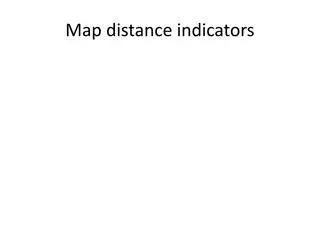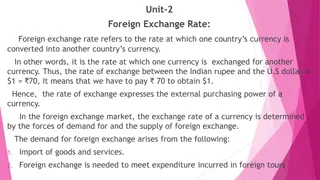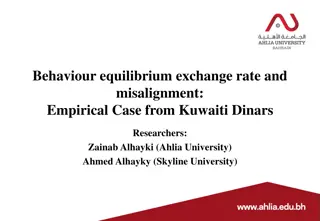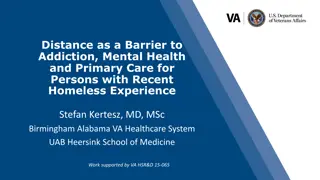Managing Interest Rate and Currency Risks: Strategies and Considerations
Interest rate and currency swaps are powerful tools for managing interest rate and foreign exchange risks. Firms face interest rate risk due to debt service obligations and holding interest-sensitive securities. Treasury management is key in balancing risk and return, with strategies based on expect
3 views • 21 slides
Improving Heat Rate Efficiency at Illinois Coal-Fired Power Plants
Heat rate improvements at coal-fired power plants in Illinois are crucial for enhancing energy conversion efficiency, reducing carbon intensity, and minimizing pollution. By increasing the heat rate/efficiency by 6%, these plants can generate more electricity while burning the same amount of coal. T
2 views • 11 slides
Wage Remuneration Methods Overview
Dr. B. N. Shinde, Assistant Professor at Deogiri College, Aurangabad, presents an insightful overview of methods of wage remuneration including Time Rate System, Piece Rate System, and Combination of Time and Piece Rate System. Time Rate System is the oldest method where workers are paid based on ti
0 views • 16 slides
Understanding Distance Indicators and Travel Time Estimation
Distance indicators are used on maps to show distances between locations, aiding in journey planning. Travel time estimation rules help calculate journey durations based on average speeds and external factors. Distance tables assist tourists in determining distances between cities. Learn how to use
0 views • 9 slides
Transmission Rate Change Overview for June 1, 2020
Presentation on the Rate Change effective June 1, 2020, detailing RNS Rate adjustments, Annual Transmission Revenue Requirements, and Regional Forecasts. The RNS Rate increased to $129.26/kW-year reflecting transmission project impacts, while ATRR analysis showed changes in revenue requirements for
0 views • 25 slides
Understanding Distance and Displacement in Science
Exploring the concepts of distance and displacement in science, this content covers the difference between scalar and vector quantities, methods for determining displacement and distance, and examples of scalars and vectors. It also delves into the fundamental definitions of distance and displacemen
0 views • 21 slides
Rate Optimization in Wideband RIS-assisted Wireless Systems
This research focuses on rate optimization in wideband RIS-assisted wireless systems, specifically investigating MIMO RIS-assisted systems in sub-6 GHz mmWave settings. Pathloss and blockage modeling, along with LOS vs. spectral efficiency and RIS-UE distance vs. spectral efficiency analyses, are ke
0 views • 4 slides
Understanding Foreign Exchange Rates and Market Forces
Foreign exchange rate is the rate at which one country's currency is converted into another's, reflecting purchasing power. The rate is determined by demand and supply in the foreign exchange market, influenced by factors like imports, exports, investments, and speculation. Equilibrium rate is reach
0 views • 42 slides
Understanding Data Rate Limits in Data Communications
Data rate limits in data communications are crucial for determining how fast data can be transmitted over a channel. Factors such as available bandwidth, signal levels, and channel quality influence data rate. Nyquist and Shannon's theoretical formulas help calculate data rate for noiseless and nois
0 views • 4 slides
Understanding Heart Rate Variations During Rest and Exercise
This experiment focuses on measuring heart rate at rest and after physical exercise, exploring the factors that influence heart rate changes. Through hands-on activities and theoretical lessons, students learn about the cardiac cycle, the circulatory system, and the impact of physical exertion on he
1 views • 22 slides
Estimation of Drying Time in Spray Drying Process: Diffusion and Falling Rate Periods
The estimation of drying time in a spray drying process involves understanding diffusion-controlled falling rate periods, constant rate periods, and the mechanisms by which moisture moves within the solid. The drying rate curves depend on factors like momentum, heat and mass transfer, physical prope
0 views • 8 slides
Understanding Distance, Speed, and Acceleration in Physics
Explore the concepts of distance, speed, and acceleration in physics with practical examples and calculations. Learn how to calculate speed, interpret distance-time graphs, differentiate between speed and velocity, and understand acceleration through scenarios involving various moving objects. Gain
9 views • 12 slides
Empirical Analysis of Kuwaiti Dinar Exchange Rate Behavior and Misalignment
This research focuses on studying the behavior of the real equilibrium exchange rate (REER) of Kuwaiti Dinars, estimating the equilibrium exchange rate using the BEER model, and calculating real exchange misalignments (RERM). It delves into the impact of exchange rate fluctuations on macroeconomic v
0 views • 15 slides
Understanding Electronic Distance Measurement in Surveying
Electronic Distance Measurement (EDM) is a precise method for measuring distances between two points using electromagnetic waves. It offers speed and accuracy, especially useful for long or inaccessible distances. EDM, a type of surveying instrument, measures phase changes in energy waves traveling
0 views • 7 slides
Solving Work Problems with Rational Equations
Learn how to solve work problems involving rational equations. Find the least common denominator, multiply by it, and solve for the variables. Practice examples like determining how long it takes workers to finish a task when working together. Also, solve distance equals rate times time problems to
0 views • 7 slides
Study on the Relationship Between Release Distance and Bounce Distance of Golf Ball
Experiment investigating how the release distance affects the bounce distance of a golf ball from bounce one to bounce two. The hypothesis suggests that a greater release distance will result in the ball traveling farther. Controlled variables include the angle of the ramp, ball, height, and surface
0 views • 13 slides
Experiment on Golf Ball Bounce Distances
This experiment explores how the release distance affects the bounce distance of a golf ball, showing that a higher release distance leads to a greater distance between bounces. By conducting controlled drops and measurements, the hypothesis regarding the impact of momentum on the ball's travel dist
0 views • 10 slides
Understanding Minimum Edit Distance in Computational Linguistics
Edit distance, such as Levenshtein distance, quantifies the similarity between strings by counting operations needed for transformation. It finds applications in spell correction, DNA sequence alignment, machine translation, and speech recognition. The minimum edit distance measures the minimum numb
0 views • 40 slides
Understanding Speed and Motion: Equations, Calculations, and Graphs
Speed is defined as the distance traveled per unit of time and is measured using the equation Speed = Distance/Time, with units typically in meters per second (m/s). To calculate speed, measure the distance traveled and the time taken. Motion graphs can be used to visualize speed by plotting time on
2 views • 11 slides
Understanding Behavioral Market Efficiency
In the realm of finance, efficient markets are described by Eugene Fama as those where prices reflect all available information. However, the distinction between public and private information can be unclear. The concept of market efficiency is further expounded through the Price-equals-value and Ha
0 views • 51 slides
Distance, Rate, Time in Motion Problems Explained
Solving distance, rate, time problems involving hiking speeds, biking distances, and travel times. Learn how to calculate average walking speeds, total distances traveled in given time durations, and time differences between varying travel rates.
0 views • 4 slides
SFMTA Taxi Meter Rate Proposal - September 2022
SFMTA is proposing a taxi meter rate increase in San Francisco, the first since 2011. The proposal includes raising the flag drop, distance, and waiting time rates. The median cost for all trips is $12.85, with fare components varying by trip distance. A comparison of metered fares across jurisdicti
0 views • 14 slides
Understanding Chemical Equilibrium in Reversible Reactions
Chemical equilibrium occurs when the concentrations of reactants and products remain constant over time in a reversible reaction. Reaction rate is proportional to concentration, and equilibrium is reached when the rate of formation equals the rate of consumption in both directions. Reversible reacti
0 views • 25 slides
Addressing Sewer Rate Changes and Structural Remedies
City's sewer rate changes history and underfunding issues due to lack of cost centering, overburdening the general fund, and inadequate capital project funding. The methodology for rate review highlights the need for reflective rates to cover service costs. The current rate structure shows deficienc
0 views • 19 slides
Understanding Sight Distance and Stopping Sight Distance in Traffic Engineering
Sight distance is crucial for drivers to spot obstacles and pass safely on highways. Stopping Sight Distance (SSD) is the minimum distance required for a vehicle to stop before reaching a stationary object. Factors affecting SSD include reaction time, speed, and road conditions. Passing Sight Distan
0 views • 15 slides
Understanding E-Rate Program: Education Discounts & Benefits
The E-Rate Program, also known as Education Rate, offers discounts to schools and libraries for affordable telecommunications and Internet access. Administered by USAC, this program aims to provide crucial funding and support to educational institutions. With an annual budget of $3.9 billion and dis
0 views • 35 slides
Understanding Rolle's Theorem and The Mean Value Theorem in Calculus
Rolle's Theorem states that for a continuous and differentiable function on a closed interval with equal function values at the endpoints, there exists at least one point where the derivative is zero. The Mean Value Theorem asserts that for a continuous and differentiable function on an interval, th
0 views • 5 slides
Understanding Non-Traditional Students in Distance Education
This presentation explores the definition of non-traditional students in the context of distance education, outlining characteristics such as delayed enrollment, part-time attendance, full-time work, financial independence, dependents, single parenthood, and lack of a high school diploma. It also di
0 views • 15 slides
Understanding Rate Expressions in Heterogeneous Systems
In heterogeneous systems, the rate expression involves mass transfer terms alongside chemical kinetics terms due to the presence of multiple phases. Different types of heterogeneous systems have varying mass transfer complexities, making a general rate expression challenging to define. Examples such
0 views • 29 slides
Exploring Distance Bounding: Facts, Hopes, and Perspectives
Delve into the world of distance bounding with Maria Cristina Onete as she discusses the secure authentication, relay attacks, distance-bounding protocols, properties, and attacks. Learn about the challenges and implementations of mobile distance bounding, mafia and terrorist fraud resistance, and h
0 views • 34 slides
Utilizing Distance Data in Statistics: Insights from Denmark
Exploring the essential role of distance data in statistical analysis, this content sheds light on various methods such as pure distance measurements, proximity analysis, and distance calculations between different points like summer cottages and coastal lines in Denmark. From analyzing catchment ar
0 views • 9 slides
SMMPA Annual Meeting Transmission Rate Update 2018
SMMPA, a not-for-profit political subdivision in Minnesota, updated its transmission rate formula in August 2018. The Attachment O timeline outlines crucial dates for stakeholders, including the annual meeting on formula rate updates. SMMPA, as a Transmission Owner in MISO, follows FERC-approved tem
0 views • 8 slides
Distance as a Barrier to Healthcare Access for Individuals with Recent Homeless Experience
The study explores the impact of geographic distance on healthcare access for individuals with recent homeless experience. It assesses the association between distance to VA facilities and perceived barriers to care, as well as the relationship between perceived distance barriers and utilization of
0 views • 25 slides
Understanding Forces and Stopping Distances in Vehicle Safety
Explore the forces that oppose vehicle motion, and learn about thinking distance, braking distance, and stopping distance. Discover how factors affect these distances, such as friction and reaction time. Gain insights into how friction helps in braking systems and the impact of accelerating or braki
0 views • 16 slides
Understanding Heart Rate and Pulse: Key Differences and Measurement
Heart rate, also known as pulse, is the number of times your heart beats per minute. It varies based on factors like age, fitness level, and emotions. Pulse is a direct measure of heart rate. Learn about the differences between heart rate and blood pressure, how to measure heart rate, and what const
0 views • 8 slides
Understanding Motion, Speed, Velocity, and Acceleration
Motion is when an object changes its place or position. To describe motion accurately, consider the start and end position, movement relative to a reference point, distance traveled, and direction. Speed refers to the distance traveled per unit of time and can be calculated using the formula speed (
0 views • 25 slides
General Architecture of Kookmin University's Image Sensor Communication Proposal
Kookmin University submitted a proposal to the IEEE P802.15 Working Group for Wireless Personal Area Networks, focusing on the PHY and MAC layers for image sensor communication. The document outlines design principles, specifications, frame formats, and considerations for both layers. Definitions re
0 views • 41 slides
Understanding Bacterial Growth and Nutritional Requirements
Bacterial growth involves processes like binary fission, exponential phase, and stationary phase. Factors influencing growth include nutrient availability, oxygen levels, and toxic waste accumulation. Lag phase precedes exponential growth, where cells prepare for division. Stationary phase occurs wh
0 views • 11 slides
Practice Questions on Speed and Distance with Solutions
Practice solving speed and distance problems with the provided solutions for scenarios involving a bullet, Bill jogging, and an airplane journey from New York to Los Angeles. Understand how to calculate speed, average speed, and arrival time based on distance and time measurements. Improve your arit
0 views • 34 slides
Exploring Speed and Distance Estimation in Speed Trap Lab
Dive into the world of speed and distance estimation with the Speed Trap Lab. Learn how to calculate speed and distance, taking into consideration uncertainties and variations in time measurements. Explore the relationship between distance, time, and speed through engaging visual aids and practical
0 views • 4 slides







































